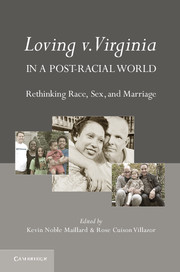Book contents
- Frontmatter
- Contents
- About the Contributors
- Acknowledgments
- Foreword
- Introduction Loving v. Virginia in a Post-Racial World
- Part One Explaining Loving v. Virginia
- Part Two Historical Antecedents to Loving
- Part Three Loving and Interracial Relationships: Contemporary Challenges
- 6 The Multiracial Epiphany, or How to Erase an Interracial Past
- 7 Love at the Margins
- 8 The Crime of Loving
- 9 What’s Loving Got to Do with It?
- 10 Fear of a “Brown” Planet
- Part Four Considering the Limits of Loving
- Part Five Loving Outside the U.S. Borders
- Part Six Loving and Beyond: Marriage, Intimacy, and Diverse Relationships
- Permission Granted
- Index
- References
6 - The Multiracial Epiphany, or How to Erase an Interracial Past
Published online by Cambridge University Press: 05 July 2012
- Frontmatter
- Contents
- About the Contributors
- Acknowledgments
- Foreword
- Introduction Loving v. Virginia in a Post-Racial World
- Part One Explaining Loving v. Virginia
- Part Two Historical Antecedents to Loving
- Part Three Loving and Interracial Relationships: Contemporary Challenges
- 6 The Multiracial Epiphany, or How to Erase an Interracial Past
- 7 Love at the Margins
- 8 The Crime of Loving
- 9 What’s Loving Got to Do with It?
- 10 Fear of a “Brown” Planet
- Part Four Considering the Limits of Loving
- Part Five Loving Outside the U.S. Borders
- Part Six Loving and Beyond: Marriage, Intimacy, and Diverse Relationships
- Permission Granted
- Index
- References
Summary
In the collective memory of the United States, mixed race did not exist until 1967. By giving legal recognition to interracial marriage, Loving v. Virginia established a new context for racial possibilities in the United States. In addition to allowing marriage across the color line, Loving required states to give legal credence to the existence of interracial sex and romance. In theory, Loving, as a juridical approval of race mixing, heralds the development of a racially nuanced and complex America. This decriminalization shifted the legal discourse of miscegenation from illicit to legitimate, beginning with the status of the mixed-race offspring. For the children of Loving, legal obstacles to interracial kinship became a thing of the past.
Praise of Loving as a transformative decision limits itself to a post-1967 epiphanic moment that heralds the arrival of a new, multiracial United States. Professor Jim Chen notes that “[i]ntermarriage and its handmaiden, interbreeding, are running riot in America.” From another angle, Deborah Ramirez declares that “the number of biracial babies is increasing at a faster rate than the number of monoracial babies.” Mass media express wonder at the “biracial baby boom,” and open declarations of mixed parentage are common, perhaps even fashionable. Novelist Danzy Senna (who is black, white, and Jewish) proclaims that “America loves us in all our half-caste glory.” In a combination of popular and scholarly work, Gary Nash gloriously portends:
The invisible Berlin Wall, the racial wall, is being dismantled stone by stone. … Today, in Hawaii, 60 percent of babies born each year are of mixed race. In Los Angeles County, the rise in the percentage of Japanese American women who marry out of their ethnic group has risen from one of every ten in the 1950s to two of three today. Similar trends pertain to other Asian American groups. Seventy percent of American Indians tie bonds with mates who are not Indian. Even the most enduring nightmare of Euroamerica – racial intermarriage between Black and white partners – is no longer extraordinary. Outside the South, more than 10 percent of all African American males today marry non-Black women, and Black-white marriages nationwide have tripled since 1970. Mestizo America is a happening thing. A multiracial baby boom is occurring in America today.
- Type
- Chapter
- Information
- Loving v. Virginia in a Post-Racial WorldRethinking Race, Sex, and Marriage, pp. 91 - 100Publisher: Cambridge University PressPrint publication year: 2012

